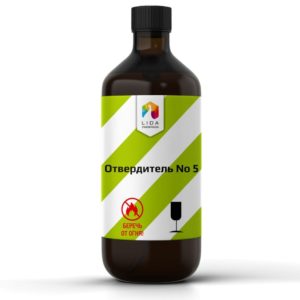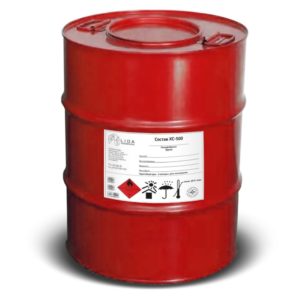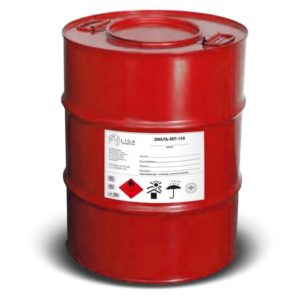Specifications :
| No | The name of indicators | Requirements TNPA | ||
| “TermoLid 600” | “TermoLid 600 M” | |||
| one | Enamel coating color | Silver, must be within tolerances set by approved reference color samples. | Silver or silver-gray, the color is not normalized | |
| 2 | The appearance of the enamel coating | After drying, the enamel should form a smooth, uniform and without foreign inclusions. | After drying, the enamel should form a uniform, without defects and foreign inclusions surface | |
| 3 | Conditional viscosity according to VZ-246 viscometer with a nozzle diameter of 4 mm (VZ-4) at a temperature of (20.0 ± 0.5) ° С, s | 25 – 60 | ||
| four | Mass fraction of nonvolatile substances,% | 44 – 48 | 40 – 50 | |
| five | Drying time to degree 3 at a temperature, h, not more than (20 ± 2) ° С (150 ± 2) ° С(125 – 130) ° С |
20.5
– |
2–
0.5
|
|
| 6 | The heat resistance of the coating at a temperature
(600 ± 5) ° С, h, not less |
five | 3 | |
| 7 | Adhesion of coating, points, not more | one | ||
| eight | Coating hardness by pendulum device type TML (pendulum A), relative units, not less | 0.2 | ||
| 9 | Coating strength at impact on the device U-1, cm, not less | – | 45 | |
| ten | Spreading dried coating, g / m 2 ,
no more |
90 | – | |
| eleven | Delamination, cm 3 , not more | – | ten | |
| 12 | The resistance of the coating to static effects at a temperature of (20 ± 2) ° С, h,
not less: distilled water gasoline (nefras-C2-80 / 120) industrial oil |
100
96 96 |
||
| 13 | Coating resistance, cycles, not less | – | 13 | |
| 14 | Resistance of the coating to the effects of salt fog, h, not less | – | 240 | |
Преимущества: Эмали образуют термостойкие покрытия, выдерживающие воздействие температуры до 600 °С. Покрытия эмалями обладают повышенной влаго-, масло- и бензостойкостью.
Рекомендации по нанесению эмали «ТермоЛид 600».
1 Подготовка поверхности под окраску
Подготовку поверхности изделия под окраску грунтовкой проводят в соответствии с требованиями ТНПА на изделие, ГОСТ 9.402 или СТБ ISO 12944-4.
The surface to be painted must be free from rust, scale and other contaminants (it is necessary to remove incisions, burrs, welding spatters, round sharp edges, corners, teeth and welding seams; there must be no grease, marking paint and other substances, such as mineral pollution, water-soluble salts affecting the quality of surface preparation), cleaned, dedusted, degreased with solvent (GOST 10214), xylene (GOST 9410), acetone (GOST 2768) or other aromatic solvents and dried thoroughly. It is most thoroughly necessary to clean the surface in the weld zone up to 3 cm wide from residues of fluxes, alkaline slags and oxides formed during welding. Before painting, the metal surface must be dry and clean; there should be no traces of solvent on it.
Cleaning from rust, scale and residues of old paint produced manually or mechanically. To improve the protective properties of the coating of metal surfaces, it is recommended to pre-clean the sandblasting method to the degree of cleaning of oxides 1 – 2 according to GOST 9.402. Coloring is made not later than 4 hours after processing and degreasing the surface. To avoid moisture condensation, the temperature of the surface to be painted should be above the dew point temperature by at least 3 ° C.
The previously painted surfaces are cleaned of the fragile layers of the old coating, the exfoliated old coating is removed, the entire surface is cleaned, dedusted, degreased and dried. If the appearance of the old paintwork is unknown, it should be checked for compatibility (it is recommended to carry out a control painting of a small surface area). In the case of puffing or peeling, the old coating must be removed.
2 Coloring
Before use, the enamel is thoroughly mixed. Enamel is applied by pneumatic spraying, brushing or dipping. If necessary, the enamel is diluted with orthoxylene (TU BY 300042199.015) with xylene or solvent in an amount up to 30% by weight of undiluted enamel and filtered through mesh No. 01H-02H or cloth for sieves of silk and synthetic fibers with a nominal opening size of 100 to 200 microns, or several layers of gauze.
The consumer independently selects the working viscosity depending on the working conditions (ambient temperature in the room, the diameter of the spray nozzle, the working pressure of compressed air, etc.).
In the case of storage at low temperatures, the enamel is kept in a warm room before application (to avoid moisture condensation on the surface to be painted during painting) for at least 24 hours.
Coloring is not allowed during precipitation, as well as on wet and icy surfaces.
The metal surface is painted in one to two layers with interlayer drying (for a two-layer coating) for 5–7 minutes at a temperature of (20 ± 2) ° C and drying to degree 3 for 0.5 h at a temperature of (150 ± 2) ° WITH. It is allowed to carry out drying at a temperature of (20 ± 2) ° C and a relative air humidity of (65 ± 5)% for at least 2 hours. Full curing of the coating occurs at a temperature from plus 250 ° C to plus 400 ° C for 30 to 20 minutes or during operation of the painted product at a temperature of from + 250 ° С to + 600 ° С.
The thickness of the dried coating depends on the operating temperature and should be:
50 – 70 microns in the operation of products at temperatures ranging from plus 250 ° C to plus 400 ° C;
25 – 50 microns at operation of products at a temperature from plus 400 ° С to plus 600 ° С.
In the case of surface cleaning by sandblasting, the coating thickness should be increased taking into account the degree of surface roughness Ra (GOST 2789).
The enamel consumption with a dried coating thickness of 25 – 35 microns is 60 – 90 g / m² without taking into account the complexity of the painted surface, its preparation, application method, personnel qualifications and other factors.
Recommendations for applying enamel “ThermoLid 600 M”
1 Surface preparation for painting for enamel is carried out in accordance with the requirements set forth in the technological documentation of the enterprise. Before use, the enamel is thoroughly mixed. Enamel is applied by the method of pneumatic spraying, if necessary, diluted with solvent in an amount up to 30% by weight of undiluted enamel, and filtered through a cloth for sieves of silk and synthetic fibers with a nominal opening size of 100 – 200 microns. The metal surface is painted in two or three layers with interlayer drying for 5-7 minutes at a temperature of (20 ± 2) ° C and final drying to degree 3 for 0.5 h at a temperature of 125-130 ° C. It is allowed to carry out drying at a temperature of (20 ± 2) ° C and a relative air humidity of (65 ± 5)% for at least 2 hours. The thickness of the dried coating should be 35 to 45 microns. Enamel consumption when the thickness of the dried coating is 35–45 µm, it is 90–120 g / m² without taking into account the complexity of the surface to be painted, its preparation, staff qualifications and other factors.
After the enamels are used for their intended purpose, the container with the remnants of the product should be tightly closed with closures and shipped to a household landfill.
Storage: Enamel is stored and transported at a temperature from + 5 ° С to + 30 ° С. Enamels should be stored in a tightly closed container, protected from moisture and direct sunlight. Keep away from fire.
Precautionary measures: When carrying out painting works, and also after their termination, it is necessary to air the room carefully. Persons associated with painting work should be provided with personal protective equipment (workwear, goggles, rubber gloves).
The dried coating does not have a toxic effect on the environment and the human body.










